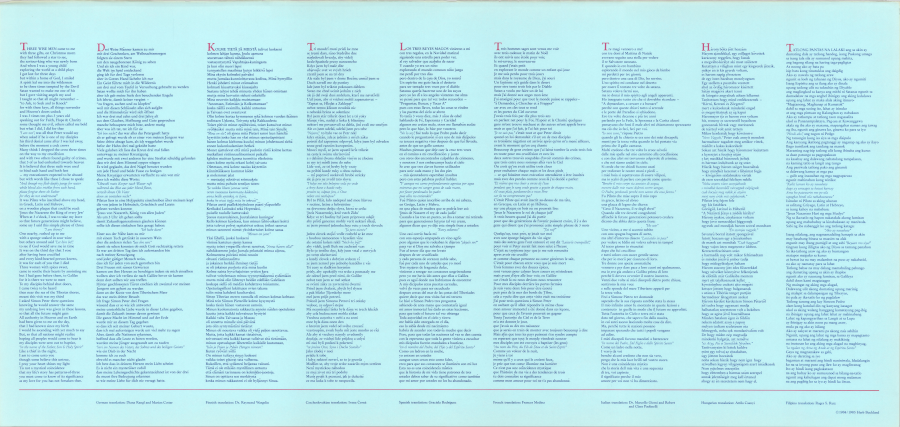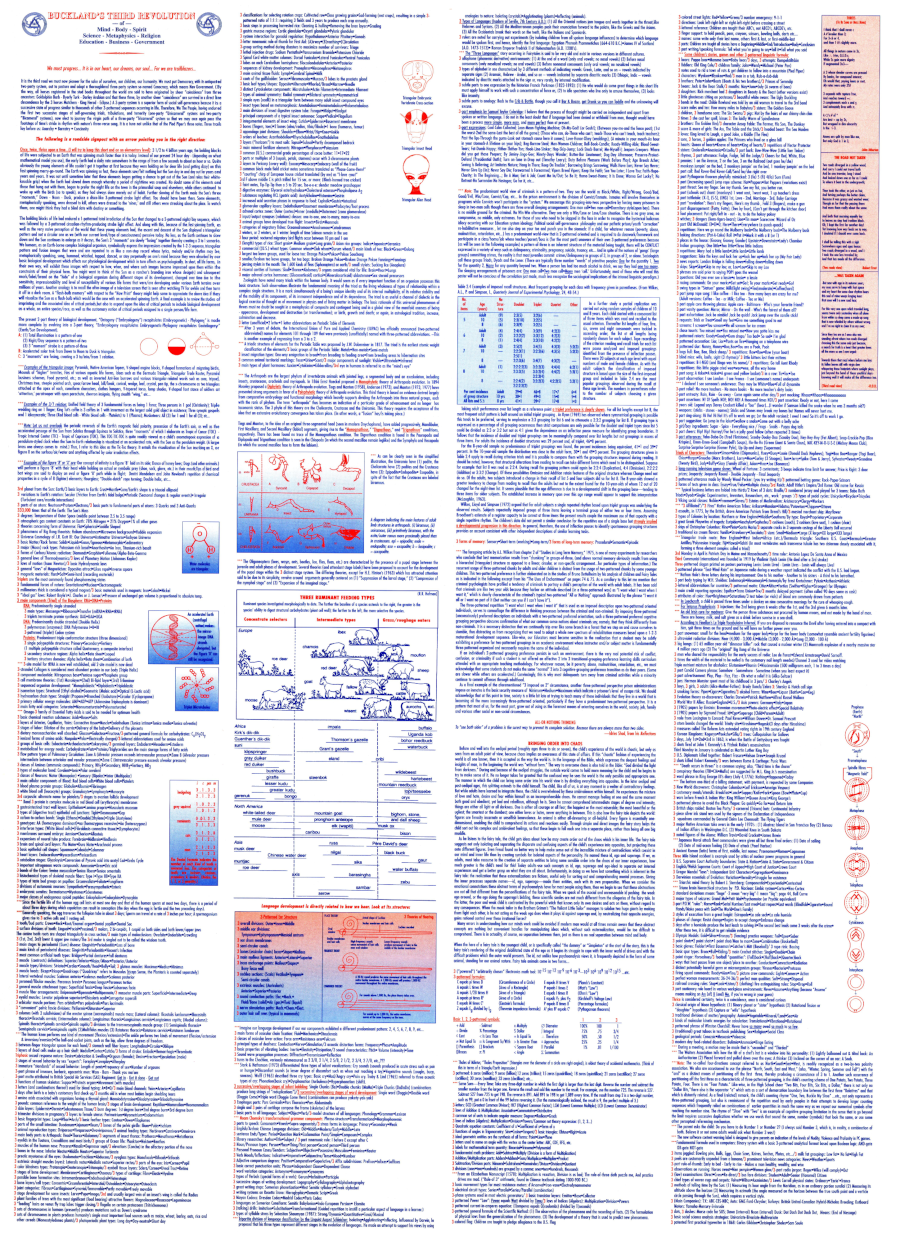(The Study of Threes)
http://threesology.org
Visitors as of March 28th 2024

(What appears to be a light streak across about the center of the poster caused by poor imaging is actually denoting the presence of a different font that is italicized for a particular example being given in the poem.)
For those of you who want an enlarged size to be copied, here is a pdf:

This first poster exhibits the shortened English Language version of a poem whose full length is 333 lines long.
From the English there are 8 different translations of the English version. The poem describes a recurring set-of-threes in the life of Jesus that were gathered (as a verification process) from 30 different sources representing the New Testament. The list is not meant to be exhaustive, merely representative of the numerous times the value of "three" was used in describing the tale of Jesus. In some cases, such as the ideas surrounding the three Wise men and the three nails used at the Crucifixion; there are no direct biblical references for these ideas. They are inferences and part of a colloquially-derived language transmission taking place over time. Again, I was not trying to catalogue all the patterns-of-three in the New Testament's declarative witnessing of Jesus. The following are a few threes in the life of Jesus not in the poem:
- Three Hours of Darkness: Darkness covered the earth for three hours during Jesus' crucifixion.
- Three Witnesses: The Transfiguration involved Jesus, Moses, and Elijah.
- Three Prayers in the Garden: Jesus prayed three times in the Garden of Gethsemane before his arrest.
Considered as a "Rhythm", here is a link to multiple Religious references focused on the "Three": Rhythm of the Number Three. Note: I first encountered the posted examples authored by Douglas Stringham. However, the old AOL link is no longer viable.
From left to right: English, German, Finnish, Czechoslovakian, Spanish, French, Italian, Hungarian, Filipino... I had acquired the Arabic, and Chinese translations but couldn't find anyone with the suitable fonts on their computer back in 1984/85. After the printing, I acquired the Danish and Portuguese translations, as well, but haven't been able to locate them in my storage unit. I have referred to it on occasion either as the Three Wise Men (TWM) poster, or Three Wise Men translations poster. Prior to printing, it was suggested by someone at the printing office that I should entitle it the "Trinity", but I said no because it was not about the trinity. I left it untitled. It is 17 1/2" X 37 1/8".
Here are links to the different translations:
| Three Wise Men Poem Translations | ||||||||
| English | German | Finnish | Czechoslovakian | Spanish | French | Italian | Hungarian | Filipino |
My personal view of the Jesus theme is that there are several considerations to take stock of. Here are a sampling:
- Jesus is a Narrative created from multiple ideas exhibited in past religious orientations, some of which could be assessed as Pagan (rural), mythology, suppositions, superstitions, fairy tales, mysticism, lies, "stupid-stitions", fabrication, etc...
- Jesus, like Mohammed of Islam, the Trimurti of Hinduism, Buddha, Zeus, Santa Claus, tooth fairy, etc., is not a real character as portrayed in religious ideology. All of them have become Larger-than-life themes forced on the naive, the gullible, the ignorant, the scared, the desperate, the impressionable youth, etc...
- The Jesus theme took on multiple Saviour themes passed around by word of mouth, with details changing to fit the time, place, culture and language of the story tellers.
- Jesus became part of a new narrative to both replace and supplant older ideas which were falling out of favor and required adherents to facilitate a new message as a revelation to control, manipulate and lead populations that would otherwise have been intractable if not for the unseen power possessed by believers who participated in a mass delusion.
- The Jesus story became a New Age soap opera drama in an Old Age that longed for a different message because the old messages no longer held the sway of practical application as civilizations evolved with myriad forms of interpretation about the intricacies of life that past peoples could not have imagined as viable considerations.
Here is the AI generated response using the query "Jesus Never Existed:"
The existence of Jesus is a subject of historical and scholarly debate.Arguments for Jesus' Existence:
- Scholarly Consensus: The vast majority of scholars of antiquity agree that a Jewish man named Jesus of Nazareth existed in the 1st century, upon whose life and teachings Christianity was later based.
- Early Non-Christian Sources: Jewish and Roman historians, such as Josephus and Tacitus, mentioned Jesus within decades of his supposed lifetime, providing evidence beyond the New Testament. Josephus, a first-century Jewish historian, refers to Jesus in his writings, including a passage about James, the brother of Jesus, who is called the Messiah. Tacitus, a Roman historian, also mentions early Christians and their worship of Christ.
- Christian Sources: The Pauline epistles and the Gospels, although having their own biases, are considered primary sources of historical information about Jesus and early Christianity.
Arguments Against Jesus' Existence (Christ Myth Theory):
- Lack of Contemporary Evidence: Mythicists argue that there are no contemporary non-Biblical eyewitness accounts and that mentions of Jesus in secular sources are later additions or interpolations.
- Unreliable Gospels: They view the New Testament as unreliable, citing contradictions and inconsistencies, and suggesting that the Gospels are products of oral tradition and evolving legends.
- Pauline Epistles and Mythology: Some argue that Paul's writings focus on a celestial or mythological Jesus rather than a historical one, influenced by Greco-Roman mystery cults.
- Lack of Archaeological Evidence: Some scholars argue that there is no archaeological verification of Jesus's existence or crucifixion, unlike other historical events like the eruption of Mount Vesuvius.
As an historical narrative of human cognition in a particular context, the time in which Jesus lived can be described as an Age of Irrationality which persists today. Recognizing the wide spread presence of Irrationality is difficult by those who are intellectually deeply embedded or emotionally invested in those cultures where Jesus and his contemporaries flourished as a primary socially recognized and accepted-as-real idea. Not only does the public encounter confirmation bias, but also denial bias... as the pendulum swings, so to speak. Much like a crazy person who has difficulty recognizing the wide spread presence of insanity when a similar mental acuity of concern is a necessary survival standard. Simply put, while in Rome, do as the Romans do... which means act similarly irrational. A similar model of this behavior is seen when Journalists adopt whatever strategy is necessary in order to be a part of a government administration's inclusive/inside group. Another example is the behavioral modifications an undercover cop or spy must append to themselves for a given context of infiltration. The time of Jesus was also an age where the mindset of Ambivalence, inter-meshed with superstition, Divination, primitive medicine, cults were widespread... though the profession of Psychology might well label this period as an Age of Schizophrenia... either as a mild neurotic form or an episodic form of Psychosis... particularly witnessed by the anti-social practices carried out by various public leaders and their followers.
Yet, if the word "Ambivalence" is defined simply as 'mixed emotions', the label "Schizophrenia" may not be seen as some disturbing, horrific, or psychotic model of mental illness. However, the analogy of using the notion of mental "flip-flopping" to describe ambivalence and thus schizophrenia, is helpful in not only describing the age in which Jesus lived, but Jesus himself. Apparently those who experienced heightened levels and types of environmental/societal stress are prone towards exhibiting ever greater models of deleterious mental illness. We see this not only throughout history with political leaders such as those of ancient Rome and elsewhere, but also religious figures such as Jesus, Mohammed, Buddha, the Roman Catholic Popes, etc... Such expressed levels of mental illness often takes on a public's collusion, much in the manner of the people not saying anything about a king who is parading in the Nude, as expressed in the tale The Emperor's New Clothes.
A good example of this "flip-floping" mental state can be seen when Jesus is recorded to have spoken about peace:
Matt: 10:34 KJV— Think not that I am come to send peace on earth: I came not to send peace, but a sword. For I am come to set a man at variance against his father, and the daughter against her mother, and the daughter in law against her mother in law. And a man's foes shall be they of his own household. He that loveth father or mother more than me is not worthy of me: and he that loveth son or daughter more than me is not worthy of me. And he that taketh not his cross, and followeth after me, is not worthy of me. He that findeth his life shall lose it: and he that loseth his life for my sake shall find it.
For a man of peace, he surely doesn't sound like it. So much for people referring to him as the Prince of Peace, when he was, like so many others during his time. (As well as extending into multiple professions today such as Psychology, Mathematics and computer language, though Science in general relies on a modified scheme of duality noted as a binary model of Naming called Binomial Nomenclature due to the language of Latin used in a History of varying types and levels of madness called the Roman Empire.)
In some circumstances, some observers may refer to (the back and forth mental swaying of) Ambivalence as a bipolar situation since it is not viewed as offensive to some sensibilities like the word "schizophrenia" which has taken on an ominous an undesirable portent of of irreversible, unredeamable, and incurable evility or simply badness or wrongness. (The word "Ambivalence" to describe Schizophrenia was coined by Eugen Bleuler. However, use of the term "schizophrenia" is often adopted by those who exaggerate the simple idea of ambivalence with extreme terms such as psychosis, yet rarely describe the situation as a mental state that can transition into more positive or negative degrees where exact labeling and understanding are non-existent or poorly established, so descriptive terms from other disorders are adopted.) The point is, the day and era of Jesus was one in which those of us living today might well view the time period as one of widespread madness if we took a time machine back to that era; with those in some social power venue of that time (religious, political, business); exhibiting more noticeable intensities of mental illness (due not only to environmental stressors but social environments of indulgence by others in positions of power), as described by the countless murders, rapes, pillaging, theft, torture, destruction and other violent acts which they carried out and became recorded by some historian of fact or fiction.
In describing the era before, during, and after Jesus as one of widespread madness which the majority of the public embraced as normalcy, we also need to look at the views of those who take it upon themselves to make an effort to defend some expression thereof as a type or category of behavior, thereby minimizing some instances while maximizing others for one reason or another, either as a participant in the mob mentality or as an attempted means of manipulating others to see things as they do, whereby a measure of asserted control is exercised. For example:
Divine madness- Conflict of consciousness madness (In later centuries viewed as ambivalence, bipolar disorder or schizophrenia.)
- Nutrition deficient madness (Typically established by a Psychiatrist and not a Psychologist.)
- Intoxicant influenced madness (Alcohol, drugs, etc...)
- Frenzy madness (Like someone yelling fire! in a crowded theater.)
- Adopting previously outlawed criminal practices as lawful enterprises because they have become acceptable social revenue operations; is the dichotomy of ambivalence taking place over decades; and is thus overlooked because the public has a short memory. (Governments are guilty of this.)
- Madness induced by the study of madness (Psychiatrists were considered to be at a higher risk of suicide compared to the general population and other medical specialties. Studies have reported that physicians, in general, have higher suicide rates than the general population... AI generated answer.)
- Madness revealed or is itself an expression of insanity
- Immorality as an expressed madness
- Enforcing laws against an insane belief in witchcraft is madness
- Religious infidelity as madness
- Treason as madness
- Practicing chemical concoctions defined as witchcraft and thus madness
- Anti-social behavior as madness
- Madness as mental illness graduated on a scale of harmlesss to the very harmful
- Non-criminal thinking among the criminal minded is a form of criminality labeled insanity or madnss
- Distinctions between the criminal, the criminally insane, and the insane or mentally ill
- Divinely inspired madness
- Biblical scripture- directed madness
- Political figure directed madness
- Charismatic figure directed madness
- Mildly expressed ambivalence versus Wildly expressed ambivalence
- Duality based extremism maddness
- Public versus private insanity
- Workplace-caused insanity
- Education-caused insanity
- Societal practices-caused insanity
- Family/neighborhood-caused innsanity
- Journalism inspired madness
- Speculative Journalism-caused madness
- Double-triple standard societal laws cause madness
- Madness and Insanity may or may not be inter-changeable in some circumstances (Societal degrees of definition vary through time and place.)
Alas, we still live in an Age of Irrationality where the once spoken of characteristic labeled as "hearing of voices" by those in the past is described by Julian Jaynes in his book "The Origin of Consciousness in the Breakdown of the Bicameral Mind." The narrative of the book discusses the mental state time periods of the Iliad and Odyssey, as reflections of a transitioning state of mental illness where hearing sounds was interpreted to be the voices of gods (thus they were "hearing voices"); yet the activity of widespread dualistic thinking is not specifically addressed, nor that there was a mental effort to exceed dual thinking in the formation of a god structure we call the triad. Similarly, whereas a theme of "threes" is dominant in the New Testament due to the mindset of later writers, the earlier writers of the old testament were more dualistically and plurality oriented. Hence, the contrast in the patterning of the biblical stories exhibits a trend in the changing state of human consciousness that has nothing whatsoever to do with any religion or Eastern philosophy. It is merely the human brain undergoing a transition which just happens to be portrayed in the bible... yet there is no expressed "Newer Testament" by which humans can illustrate a continuing change in consciousness which has nothing to do with any present day religion.
This next images represent a double-sided (front and back views) 20" X 27¾" poster containing hundreds of patterns-of-three, that was printed in 1997. It is entitled "Buckland's Third Revolution".:
| — ↑ 20" ↓ — |
FRONT PDF of first side |
BACK PDF of second side |
| ½← 27" → ½ |
| BTR column 1 | BTR column 2 | BTR column 3 | BTR column 4 | BTR column 5 | BTR column 6 | BTR column 7 | BTR column 8 | Images of posters |
Initial age Update: Saturday, March 08, 2014
Previous Page Update: Thursday, 22nd-March-2018... 7:31 AM
Last Page Update: Tuesday, 2nd April 2019... 6:16 AM
Update: Tuesday, 24rd June, 2025... 12:35 PM